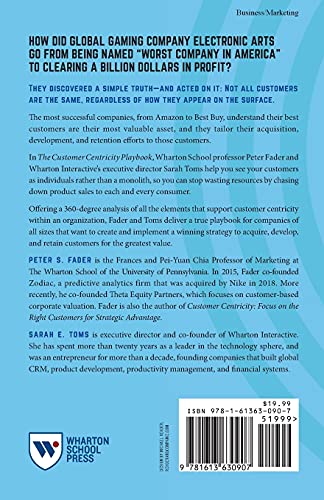Customer Services
Copyright © 2025 Desertcart Holdings Limited
Desert Online General Trading LLC
Dubai, United Arab Emirates



Wharton School Press The Customer Centricity Playbook: Implement a Winning Strategy Driven by Customer Lifetime Value
M**I
Conceitos importantes sobre Centralidade no Cliente
Gostei desse livro. Quem trabalha no tema recomendo conhecer.
M**L
Lesenswert
Zahlreiche gute Anregungen. Starker Fokus auf Marketing.
T**M
Playbook? Where are the plays?
I found out about this book by listening to "several" podcasts which featured Peter Faber. In each podcast, he said that this was the practical playbook for people wanting to implement "Customer Lifetime Value" (CLTV). Unfortunately, there are no tactical plays to run. When I think of a playbook, I thought of the analogy of football playbook... This is not one of those. This book is like the coach saying: "Run the football." But there are no "plays" in the book on how to run the ball to defeat the competition.Like another comment I saw for this book, people want to know how to calculate CLTV. Getting a historical, "past" value of a customer is easy. But predicting "future" value of the customer is what is critical. There is NO information on how to do that in this book. That would have been really useful. I've seen some of Peter's scholarly articles on how to do that, and they are really hard to decipher. I was hoping this book would put things in "simple" language that busy business owners could understand and hand off to programmers to do the work. As soon as I got the book and flipped through the pages, I didn't see any formulas for predicting future value of a customer. What a let-down...The book is also devoid of specific examples on how to use CLTV once you calculate it. The only example was at the very end of the book where the authors describe what the LA Dodgers did to increase season ticket sales. They divided the current season ticket holders into two categories. Those that are hard-core fans, and those that are price sensitive. For the hard-core fans, they were offered perks like on-field batting practice and discounts at concession stands. For the price-sensitive folks, they were offered next-season's tickets at this season's price.What I was looking for was a lot of examples like that. But that one example was basically it.I was really let down, where on page 67, they describe the process: "define the critical success factors (CSFs) of the business and identify four or five key performance indicators (KPIs) for each CSF. ..." But there are NO examples of either CSFs or KPIs, nor how it relates to customer lifetime values. Strategy without the tactics... "Just run the football..."The other odd thing about this book is it is often written in "third person." For example, "Peter did this..." What? Why phrase things like that. Peter, did you write this book, or was Sarah Toms writing your autobiography?My perception is that this book is written as a marketing vehicle for Peter to book himself onto other podcasts. He can go to the other host and say, "I wrote the playbook on the subject," just so he can get the interview. Yes he's an expert. But he didn't need this book as a "business card" to prove that.To be honest, I learned more by listening to his podcast interviews than I gained from this book. I love and respect Peter, but this was all the same stuff he already said on the podcast interviews. There was nothing new that was gained by my putting down my money to buy the book. Just listen to the free podcasts and you'll be up to speed on what is in this book.I've heard people say to judge a book's quality as if it was the only piece of information you've ever heard about the subject. That is a terrible way to judge a book. Books aren't written in a vacuum of information. I want books to have something new in them that I'm not going to find out when I listen to a podcast or watch a YouTube video. I am not only investing money when I buy a book, but I'm investing something even more important - my time to read it. I'm not getting that time back, so I better learn something new that will help me with my business. This book isn't that.Peter, if you're listening, you need to up your game on your next book. Include examples of what marketing ideas and TACTICS other companies are using, not just their strategy. Strategy by itself is too generic. Business owners want tactics. I can modify a tactic to fit my industry. But the strategy is too nebulous to take to a marketing meeting with tangible things we can do this week.
A**Y
Fails in the most fundamental way.
I have read hundreds of business books and this is one of the worst I have ever read. Don’t expect much from the 104 pages of text. Yes it’s a short book which fails to explain customer lifetime value in any useful way for a new business. Also, don’t expect to get insight in actually calculating an accurate measurement of customer lifetime value for your business. These authors seem to be lost in some type of academic bubble. You’ll have to look elsewhere for the type of information that is useful in Calculating Customer Lifetime Value in your business.
J**N
It's a good primer on the subject
I'm likely not the best judge of this book. I've been studying this topic for 20 years. I did not find much new material. However, I think this book does a very good job of introducing the subject and making the case for adopting a customer-centric strategy. If you are considering the approach and want a better understanding of why it's important and how to approach the transformation, this book is worth the read.
Trustpilot
3 weeks ago
3 weeks ago